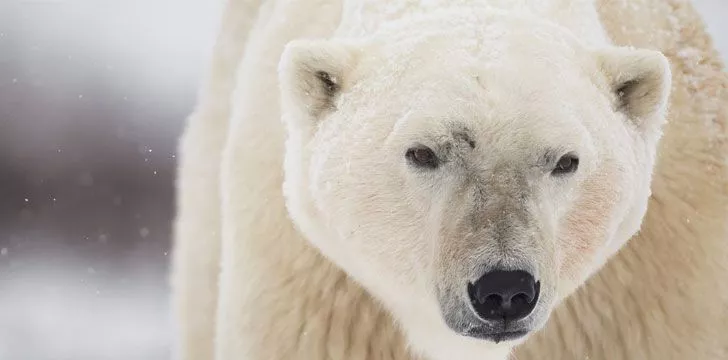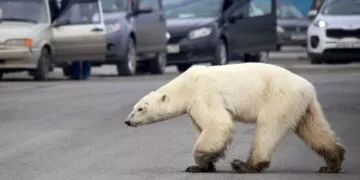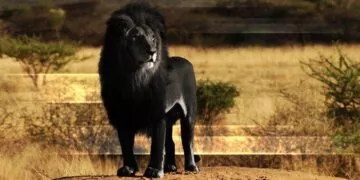You might not think there is much more to know about Polar bears, other than they are white and live in cold places.
While that may be correct, there’s way more polar bear facts that’ll give you the chills!
You would be surprised actually how complex these creatures are and how their species has developed over the years to adapt to their surroundings.
Check out these 29 cool facts about polar bears!
International Polar Bear day is held on February 27th every year.
The Latin word for polar bear is “ursus maritimus”. This translates as, ursus meaning “bear” and maritimus meaning “of the sea, maritime”.
These beautiful bears can be found on the continents of North America and Eurasia, mostly around the North of the Arctic Circle. Although some polar bears have been spotted traveling as far South as Alaska and Hudson Bay, Canada.
Although they have been known to travel as far inland as 124 miles (199 kilometers) from the shoreline, the mostly live close to or on the ice during the winter months.
As the seasons change and the ice melts, they will migrate within their individual “home range”. This will often range between 50,000 square miles to 135,000 square miles (129,499 square kilometers to 349,648 square kilometers).
An average polar bear can travel more than 1,800 miles (2,896 kilometers) in a year migrating to follow a food supply.
When traveling across the ice, polar bears can jump over ice cracks as wide as 19 feet (5.8 meters)!
Polar bears are the only bear species to be considered marine mammals, as they spend most their time on the sea ice.
Their skin is actually black. The only reason why they appear white is because their fur is translucent and reflects the light, making them appear white.
They have hairy feet, but not just to keep them warm. The bottoms of their paws are covered in small hairs to help them have traction on the ice.
When in water, polar bears can reach swimming speeds of up to 6 mph (9.6 kph).
Polar bears can swim continuously for hours and sometimes even days! Most people would think this is impossible if you aren’t a fish, but because they have huge paws, they are able to use them as paddles and they hold their feet up like rudders to steer. This allows them to save energy which means they can swim for longer without tiring.
Although they spend about half their time hunting for food, they are rarely successful. Quite often a catch is less than 2% successful.
Their main prey consists of seals and bearded seals, as well as smaller animals like birds. When needed, they will also scavenge carcasses, eggs and vegetation.
Polar bears are considered to be “hypercarnivores”, which means they have a diet that consists of more than 70% meat.
Have you heard of a Grolar Bear or Pizzly Bear? They were discovered after genetic testing in 2006 and are the nicknames for the Grizzly bear-Polar bear hybrid.
These Grolar/Pizzly bears are only birthed by polar bears, and grow up living like a polar bear, but they have brown fur.
The population of wild polar bears stands at around 26,000 (2019) and is divided into 19 sub populations. Unfortunately only one of these sub populations is on the incline, five populations are stable and 4 are in decline and as for the remaining nine, it is uncertain.
On average, male polar bears can weigh up to the same weight as ten men! That’s around 1,764 lb (800 kg).
They can grow to around 9.8 feet (3 meters) long, making them the largest land carnivores in the world.
Female polar bears are around half the size of male polar bears.
Polar bears have an extremely strong sense of smell, and therefore can smell their prey up to 0.6 miles (1 kilometer) away. They use this sense to locate the seal breathing holes in the ice.
Polar bears will track down seal holes and wait by them until the seals rise out of them to breathe and then attack. This is also known as still hunting.
Polar bears can also detect if a seal is in the water, even if there is 3 foot of snow on top of the ice.
They are also speedy when they need to be. As well as still hunting, they can attack prey from about 50-100 feet (15-30 meters) away and can build up speeds to about 25 mph (40 kph).
Sadly polar bears were one of the first species to become threatened by climate change, and they are expected to decline by 30% by the year 2050.
There are many ways to track animals using modern technology, but in recent years it has been discovered by the WWF that you can retrieve a polar bears DNA from its footprints in the snow. With only a few scoops, SPYGEN DNA specialists/scientists have found a way that you can isolate its DNA from the snow.
Other than polar bears that are pregnant, they are the only species of bear that does not hibernate during the winter. Sometimes, if it is particularly cold they will build dens and enter temporary hibernation. This is also known as carnivore lethargy.
Finally, the largest polar bear ever on record weighed a whopping 2,209 lb (1,002 kg) and was found in north western Alaska in 1960.
Polar bears are a unique species of bear and have adapted in many ways to be able to survive in their habitat.
Unfortunately with global warming and climate change, it is having a negative effect on polar bears and they could become an extinct animal a lot sooner than we had hoped.
But with incredible conservation projects, there are some areas where polar bear populations are on the rise.
With everyone’s efforts to help reduce the effects of global warming, we could help save the polar bears!


















